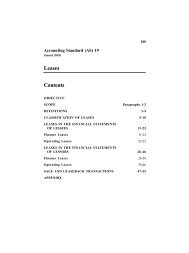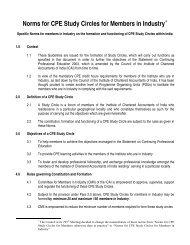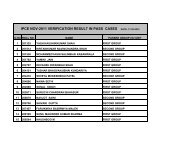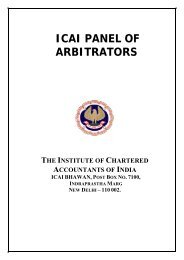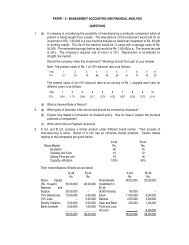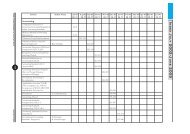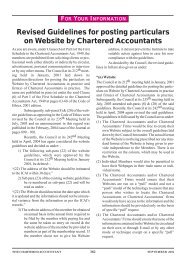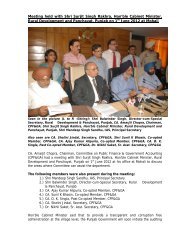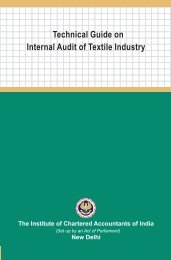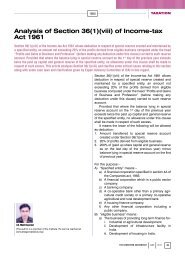The Chartered Accountant
The Chartered Accountant
The Chartered Accountant
Create successful ePaper yourself
Turn your PDF publications into a flip-book with our unique Google optimized e-Paper software.
erised applications or over the<br />
overall information technology<br />
function, for example, access<br />
or program change controls.<br />
22. Based on the results of the<br />
tests of control, the internal auditor<br />
should evaluate whether the<br />
internal controls are designed and<br />
operating as contemplated in the<br />
preliminary assessment of control<br />
risk. <strong>The</strong> evaluation of deviations<br />
may result in the internal auditor<br />
concluding that the assessed level<br />
of control risk needs to be revised.<br />
In such cases, the internal auditor<br />
would modify the nature, timing<br />
and extent of planned substantive<br />
procedures.<br />
23. <strong>The</strong> internal auditor should<br />
consider whether the internal<br />
controls were in use throughout<br />
the period. If substantially different<br />
controls were used at different times<br />
during the period, the auditor would<br />
consider each separately. A breakdown<br />
in internal controls for a specific<br />
portion of the period requires<br />
separate consideration of the nature,<br />
timing and extent of the audit procedures<br />
to be applied to the transactions<br />
and other events of that period.<br />
<strong>The</strong> internal auditor would obtain audit<br />
evidence as to the nature, timing<br />
and extent of any changes in the entity’s<br />
accounting and internal control<br />
systems since such procedures were<br />
performed and assess their impact on<br />
the auditor’s intended reliance.<br />
Monitoring Internal Audit<br />
Findings<br />
24. <strong>The</strong> internal auditor should<br />
identify internal control weaknesses<br />
that have not been corrected<br />
and make recommendations<br />
to correct those weaknesses. <strong>The</strong><br />
internal auditor should document<br />
the rationale in deciding which<br />
audit recommendations should<br />
be followed up on and when, in<br />
contrast with recommendations<br />
where no follow-up is needed.<br />
<strong>The</strong> internal auditor should also<br />
follow up with management to<br />
DECEMBER 2008 1116 THE CHARTERED ACCOUNTANT<br />
EXPOSURE DRAFTS<br />
document either that audit recommendations<br />
have been effectively<br />
implemented, or that senior management<br />
has accepted the risk of<br />
not implementing the recommendations.<br />
Communication of Continuing<br />
Internal Control Weaknesses<br />
25. When internal controls are<br />
found to contain continuing weaknesses,<br />
the internal auditor should<br />
consider whether:<br />
m Management has increased<br />
supervision and monitoring;<br />
m Additional or compensating<br />
controls have been instituted;<br />
and/or<br />
m Management accepts the<br />
risk inherent with the control<br />
weakness.<br />
26. <strong>The</strong> internal auditor should<br />
evaluate identified control deficiencies<br />
and then determine<br />
whether those deficiencies, individually<br />
or in combination, are<br />
significant deficiencies or material<br />
weaknesses. <strong>The</strong> auditor should<br />
communicate significant deficiencies<br />
and material weaknesses to<br />
management and those charged<br />
with governance. This communication<br />
includes significant deficiencies<br />
and material weaknesses identified<br />
and communicated to management<br />
and those charged with governance<br />
in prior audits but not yet remediated.<br />
27. Some examples of common<br />
weaknesses in internal controls are:<br />
m Corporate philosophy is understood<br />
but not written, open<br />
to misinterpretation;<br />
m Roles and responsibilities are<br />
not explicit throughout the entity;<br />
m Lack of performance appetite<br />
and understanding of the entity’s<br />
appetite for risk taking;<br />
m Management or boards do not<br />
receive the right information at<br />
the right time;<br />
m Disincentives exist which lead<br />
employees to behave in a dysfunctional<br />
manner.<br />
28. As a result of obtaining an understanding<br />
of the internal control<br />
systems and tests of control, the internal<br />
auditor may become aware of<br />
weaknesses in the systems. <strong>The</strong> internal<br />
auditor should make management<br />
aware, as soon as practical<br />
and at an appropriate level of<br />
responsibility, of material weaknesses<br />
in the design or operation<br />
of the internal control systems,<br />
which have come to the internal<br />
auditor’s attention. <strong>The</strong> communication<br />
to management of material<br />
weaknesses would ordinarily be in<br />
writing, as part of the internal audit<br />
report. However, if the internal auditor<br />
judges that oral communication<br />
is appropriate, such communication<br />
would be documented in the audit<br />
working papers. It is important to indicate<br />
in the communication that only<br />
weaknesses which have come to the<br />
internal auditor’s attention as a result<br />
of the audit have been reported and<br />
that the examination has not been<br />
designed to determine the adequacy<br />
of internal control for management<br />
purposes.<br />
29. <strong>The</strong> internal auditor in his report<br />
to the management, should<br />
provide:<br />
m A description of the significant<br />
deficiency or material<br />
weakness in internal control.<br />
m His opinion on the possible<br />
effect of such weakness on<br />
the entity’s control environment.<br />
Effective Date<br />
30. This Standard on Internal Audit<br />
is applicable to all internal audits<br />
commencing on or after ______.<br />
Earlier application of the SIA is<br />
encourage.q



